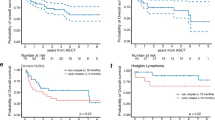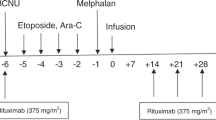Abstract
The major cause of treatment failure following high-dose therapy with autologous stem cell transplantation (ASCT) for aggressive B cell non-Hodgkin’s lymphoma (NHL) is persistent disease or recurrence. We describe our experience with the administration of rituximab post-ASCT, either as maintenance therapy or for the treatment of relapsed disease in patients with aggressive B cell NHL. Fifty-six patients achieved complete remission post-transplant, and 19 of them received maintenance with rituximab. Maintenance with rituximab resulted in statistically significant superior outcome in terms of progression free (PFS; p = 0.002) and overall survival (OS; p = 0.011). The median PFS and OS of patients in the maintenance arm has not been reached yet, while the median PFS and OS of patients in the control arm were 29 and 42 months, respectively. Fifty-four patients had disease progression or relapsed post-ASCT, and 15 of them received rituximab in combination with chemo- and/or radiotherapy in order to achieve disease remission. Therapeutic administration of rituximab resulted in statistically significant prolongation of OS (p = 0.021). The median OS of patients treated with rituximab was 17 months, while median OS of patients in the control group was 10 months. We consider that the results of our study are promising but need to be verified within large randomized trials.





Similar content being viewed by others
References
Tsirigotis P, Economopoulos T (2008) Monoclonal antibodies in the treatment of lymphoid malignancies. J Steroid Biochem Mol Biol 108:267–271
Buckstein R, Imrie K, Spaner D, Potichnyj A, Robinson JB, Nanji S et al (1999) Stem cell function and engraftment is not affected by “in vivo purging” with rituximab for autologous stem cell treatment for patients with low-grade non-Hodgkin’s lymphoma. Semin Oncol 26:115–122
Philip T, Guglielmi C, Hagenbeek A, Somers R, Van der Lelie H, Bron D et al (1995) Autologous bone marrow transplantation as compared with salvage chemotherapy in relapses of chemotherapy-sensitive non-Hodgkin’s lymphoma. N Engl J Med 333:1540–1545
Smith SM, Grinblatt D, van Besien K (2002) Autologous and allogeneic transplantation for aggressive NHL. Cytotherapy 4:223–240
Cheson BD, Horning SJ, Coiffier B, Shipp MA, Fisher RI, Connors JM et al (1999) Report of an international workshop to standardize response criteria for non-Hodgkin’s lymphomas. NCI Sponsored International Working Group. J Clin Oncol 17:1244
Juweid ME, Wiseman GA, Vose JM, Ritchie JM, Menda Y, Wooldridge JE et al (2005) Response assessment of aggressive non-Hodgkin’s lymphoma by integrated International Workshop Criteria and fluorine-18-fluorodeoxyglucose positron emission tomography. J Clin Oncol 23:4652–4661
McLaughlin P, Grillo-Lopez AJ, Link BK, Levy R, Czuczman MS, Williams ME et al (1998) Rituximab chimeric anti-CD20 monoclonal antibody therapy for relapsed indolent lymphoma: half of patients respond to a four-dose treatment program. J Clin Oncol 16:2825–2833
Hiddemann W, Kneba M, Dreyling M, Schmitz N, Lengfelder E, Schmits R et al (2005) Frontline therapy with rituximab added to the combination of cyclophosphamide, doxorubicin, vincristine, and prednisone (CHOP) significantly improves the outcome for patients with advanced-stage follicular lymphoma compared with therapy with CHOP alone: results of a prospective randomized study of the German Low-Grade Lymphoma Study Group. Blood 106:3725–3732
Marcus R, Imrie K, Belch A, Cunningham D, Flores E, Catalano J et al (2005) CVP chemotherapy plus rituximab compared with CVP as first-line treatment for advanced follicular lymphoma. Blood 105:1417–1423
Coiffier B, Haioun C, Ketterer N, Engert A, Tilly H, Ma D et al (1998) Rituximab (anti-CD20 monoclonal antibody) for the treatment of patients with relapsing or refractory aggressive lymphoma: a multicenter phase II study. Blood 92:1927–1932
Coiffier B, Lepage E, Briere J, Herbrecht R, Tilly H, Bouabdallah R et al (2002) CHOP chemotherapy plus rituximab compared with CHOP alone in elderly patients with diffuse large-B-cell lymphoma. N Engl J Med 346:235–242
Pfreundschuh M, Trumper L, Osterborg A, Pettengell R, Trneny M, Imrie K et al (2006) CHOP-like chemotherapy plus rituximab versus CHOP-like chemotherapy alone in young patients with good-prognosis diffuse large-B-cell lymphoma: a randomised controlled trial by the MabThera International Trial (MInT) Group. Lancet Oncol 7:379–391
Gisselbrecht C (2008) Use of rituximab in diffuse large B-cell lymphoma in the salvage setting. Br J Haemato 143:607–621
Belhadj K, Delfau-Larue MH, Elgnaoui T, Beaujean F, Beaumont JL, Pautas C et al (2004) Efficiency of in vivo purging with rituximab prior to autologous peripheral blood progenitor cell transplantation in B-cell non-Hodgkin’s lymphoma: a single institution study. Ann Oncol 15:504–510
Rohatiner A, Gregory WM, Peterson B, Borden E, Solal-Celigny P, Hagenbeek A et al (2005) Meta-analysis to evaluate the role of interferon in follicular lymphoma. J Clin Oncol 23:2215–2223
Nagler A, Ackerstein A, Or R, Naparstek E, Slavin S (1997) Immunotherapy with recombinant human interleukin-2 and recombinant interferon-a in lymphoma patients postautologous marrow or stem cell transplantation. Blood 89:3951–3959
Khouri IF, Saliba RM, Hosing C, Okoroji GJ, Acholonu S, Anderlini P et al (2005) Concurrent administration of high-dose rituximab before and after autologous stem-cell transplantation for relapsed aggressive B-cell non-Hodgkin’s lymphomas. J Clin Oncol 23:2240–2247
Horwitz SM, Negrin RS, Blume KG, Breslin S, Stuart MJ, Stockerl-Goldstein KE et al (2004) Rituximab as adjuvant to high-dose therapy and autologous hematopoietic cell transplantation for aggressive non-Hodgkin lymphoma. Blood 103:777–783
Rapoport AP, Meisenberg B, Sarkodee-Adoo C, Fassas A, Frankel SR, Mookerjee B et al (2002) Autotransplantation for advanced lymphoma and Hodgkin’s disease followed by post-transplant rituxan/GM-CSF or radiotherapy and consolidation chemotherapy. Bone Marrow Transplant 29:303–312
Haioun C, Mounier N, Emile JF, Bologna S, Coiffier B, Tilly H et al (2007) Rituximab compared to observation after high-dose consolidative first-line chemotherapy (HDC) with autologous stem cell transplantation in poor-risk diffuse large B-cell lymphoma: Updated results of the LNH98-B3 GELA study. J Clin Oncol 25:444s (Abstract 8012)
Vose JM, Zhang MJ, Rowlings PA, Lazarus HM, Bolwell BJ, Freytes CO et al (2001) Autologous transplantation for diffuse aggressive non-Hodgkin’s lymphoma in patients never achieving remission: a report from the Autologous Blood and Marrow Transplant Registry. J Clin Oncol 19:406–413
Hamadani M, Benson DM, Hofmeister CC, Elder P, Blum W, Porcu P et al (2009) Allogeneic stem cell transplantation for patients with relapsed chemorefractory non-Hodgkin lymphomas. Biol Blood Marrow Transplant 15:547–553
Doocey RT, Toze CL, Connors JM, Nevill J, Gascoyne RD, Barnett MJ et al (2005) Allogeneic haematopoietic stem cell transplantation for relapsed and refractory aggressive histology non-Hodgkin lymphoma. Br J Haematol 131:223–230
Lemieux B, Tartas S, Traulle C, Espinouse D, Thieblemont C, Bouafia F et al (2004) Rituximab-related late-onset neutropenia after autologous stem cell transplantation for aggressive non-Hodgkin’s lymphoma. Bone Marrow Transplant 33:921–923
Lee MY, Chiou TJ, Hsiao LT, Yang MH, Lin PC, Poh SB et al (2008) Rituximab therapy increased post-transplant cytomegalovirus complications in non-Hodgkin’s lymphoma patients receiving autologous hematopoietic stem cell transplantation. Ann Hematol 87:285–289
Fernandez HF, Escalon MP, Pereira D, Lazarus HM (2007) Autotransplant conditioning regimens for aggressive B-cell lymphoma: are we on the right road? Bone Marrow Transplant 40:505–513
Kuruvilla J, Pintilie M, Tsang R, Nagy T, Keating A, Crump M (2008) Salvage chemotherapy and autologous stem cell transplantation are inferior for relapsed or refractory primary mediastinal large B-cell lymphoma compared with diffuse large B-cell lymphoma. Leuk Lymphoma 49:1329–1336
Habermann TM, Weller EA, Morrison VA, Gascoyne RD, Cassileth PA, Cohn JB et al (2006) Rituximab-CHOP versus CHOP alone or with maintenance rituximab in older patients with diffuse large B-cell lymphoma. J Clin Oncol 24:3121–3127
Kewalramani T, Zelenetz AD, Nimer SD, Portlock C, Straus D, Noy A et al (2004) Rituximab and ICE as second-line therapy before autologous stem cell transplantation for relapsed or primary refractory diffuse large B-cell lymphoma. Blood 103:3684–3688
Costa LJ, Micallef IN, Inwards DJ, Johnston PB, Porrata LF, Ansell SM (2008) Time to relapse after initial therapy significantly adds to the prognostic value of the IPI-R in patients with relapsed DLBCL undergoing autologous stem cell transplantation. Bone Marrow Transplant 41:715–720
Holmberg LA, Maloney D, Bensinger W (2006) Immunotherapy with rituximab/interleukin-2 after autologous stem cell transplantation as treatment for CD20+ non-Hodgkin’s lymphoma. Clin Lymphoma Myeloma 7:135–139
Tsai D, Moore H, Hardy C, Porter D, Loh E, Vaughn D et al (1999) Rituximab (anti-CD20 monoclonal antibody) therapy for progressive intermediate-grade non-Hodgkin’s lymphoma after high-dose therapy and autologous peripheral stem cell transplantation. Bone Marrow Transplant 24:521–526
Acknowledgment
We deeply thank Mrs. Pantel-Bakst Sharon for her ongoing assistance in data management.
Author information
Authors and Affiliations
Corresponding author
Additional information
Tsirigotis and Dray contributed equally to this work.
Rights and permissions
About this article
Cite this article
Tsirigotis, P., Dray, L., Resnick, I.B. et al. Post-autologous stem cell transplantation administration of rituximab improves the outcome of patients with aggressive B cell non-Hodgkin’s lymphoma. Ann Hematol 89, 263–272 (2010). https://doi.org/10.1007/s00277-009-0808-5
Received:
Accepted:
Published:
Issue Date:
DOI: https://doi.org/10.1007/s00277-009-0808-5




